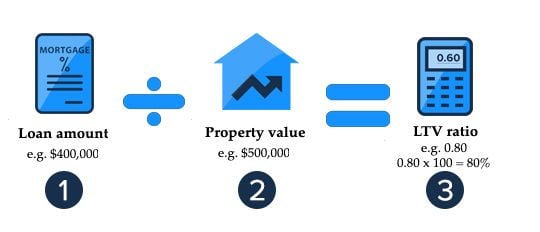Figuring out your LTV ratio can help you predict how much mortgage you’ll qualify for. But it’s far from a guarantee.
What is a loan-to-value ratio?
A loan-to-value (LTV) ratio is the size of a mortgage loan compared to the value of a property expressed as a percentage. The higher your down payment is, the lower your LTV ratio will be.
How to calculate your loan-to-value ratio
You can find your LTV ratio by dividing the amount you’ll need to borrow to purchase a property by the property’s value.
For example, if you buy a property for $500,000 and need a loan amount of $400,000 to purchase it, your LTV will be 0.80, or 80% when expressed as a percentage.
What is the LTV ratio used for?
LTV ratios are important when it comes to getting a mortgage. Generally, the lower the ratio, the lower the risk you present to your lender.
Lower LTV ratios often qualify for cheaper interest rates. Generally, a loan of 80% or less is recommended, as borrowing more leads to more fees and charges and the possibility of higher interest rates.
If you have an LTV ratio above 80%, which means you put less than 20% down, you’ll likely need to take out private mortgage insurance (PMI).
Use your LTV ratio to determine your price range
You can use your down payment amount and your goal LTV ratio to help determine how much mortgage you can afford.
For example, let’s assume that you’ve saved up $35,000 to use as a down payment and you’re hoping to take out a mortgage with an LTV ratio that’s 80% or lower so you can avoid having to pay for private mortgage insurance. An 80% LTV ratio requires you to put 20% down, so that $35,000 needs to be 20% of the total cost of the home.
(Home price) x 0.20 = $35,000
$35,000 ÷ 0.20 = $175,000
In this example, you’ll need to choose a home that costs $175,000 or less to have an LTV ratio of 80% or higher. That would leave you with a mortgage of $140,000. You can use a mortgage calculator to figure out how much you’d need to pay each month for a mortgage of that size.
Is my LTV ratio permanent?
No. As you pay off your mortgage, your loan-to-value ratio decreased. Once you own at least 20% of your home, you can ask your lender to cancel your private mortgage insurance.
If you decide to refinance your home or take out a second mortgage in the future, your LTV ratio will be recalculated.
Find the best mortgage lender for you
Compare mortgage lenders to get the best rate and terms for your needs.
Bottom line
Your loan-to-value ratio affects your ability to qualify for mortgages and how much your monthly payment will be. But a lot of other factors affect your mortgage, too — like your income, your credit score and the mortgage provider you use. Compare mortgage providers to get a better idea of what you’ll pay for a home.
Frequently asked questions
Ask a question
More guides on Finder
-
Is ONE+ by Rocket Mortgage a good deal?
Learn the ins and outs of this new low down payment program from Rocket Mortgage.
-
Rocket Mortgage vs. Bank of America
Bank of America has more loan options, but Rocket Mortgage has left a better overall impression on customers. We compare the key features between these two established lenders.
-
Mortgage refinancing options when unemployed
Refinancing your mortgage while unemployed is challenging, but it may be possible if you have an alternative means to repay the loan.
-
How much would I pay on a $550,000 mortgage?
Breakdown of what you might pay monthly over the life of a $550,000 mortgage.
-
How much would I pay on a $500,000 mortgage?
Learn more about monthly payments and interest on a $500,000 mortgage over 15 or 30 years. Plus, find out how much you need to make to afford repayments.
-
How much would I pay on a $750,000 mortgage?
Breakdown of what you might pay monthly over the life of a $750,000 mortgage.
-
How much would I pay on a $650,000 mortgage?
Breakdown of what you might pay monthly over the life of a $650,000 mortgage.
-
Chase HELOC review
Eligible customers stand to save up to 0.62% on their interest rate.
-
Mortgage affordability calculator
Check out our home loan borrowing power calculator to see if you’ll be able to afford the loan you want.
-
How is interest calculated on a mortgage?
Working out how interest is calculated on a home loan can help you figure out how much you can borrow and how to pay it off sooner.
